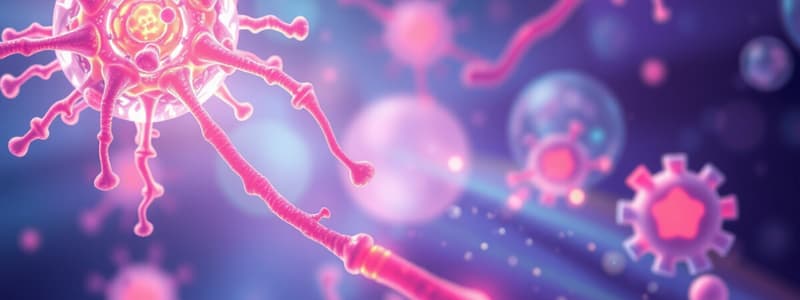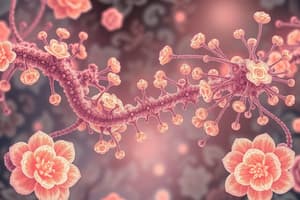Podcast
Questions and Answers
What characteristic defines a full agonist in drug-receptor interactions?
What characteristic defines a full agonist in drug-receptor interactions?
- It has 100% intrinsic activity, eliciting a maximal response. (correct)
- It binds with less affinity than an antagonist.
- It produces no response regardless of dose.
- It only activates the receptor at high concentrations.
What is the primary effect of a partial agonist at a receptor site?
What is the primary effect of a partial agonist at a receptor site?
- It entirely blocks the effects of an antagonist.
- It elicits a response comparable to a full agonist.
- It binds with full affinity but produces only partial effects. (correct)
- It has no binding affinity to the receptor.
Which statement best describes the relationship between drug concentration and biological response?
Which statement best describes the relationship between drug concentration and biological response?
- Responses increase linearly with rising doses indefinitely.
- Higher doses have no effect on biological responses.
- At higher doses, responses may plateau despite increased concentration. (correct)
- The relationship is always directly proportional.
Which scale is advantageous for comparing the effects of drugs over a larger dose range?
Which scale is advantageous for comparing the effects of drugs over a larger dose range?
What is referred to as the threshold effect in drug studies?
What is referred to as the threshold effect in drug studies?
What is typically true about the dose-response curve plotted on an arithmetic scale?
What is typically true about the dose-response curve plotted on an arithmetic scale?
How does an antagonist interact with a receptor?
How does an antagonist interact with a receptor?
Which of the following best characterizes drug-receptor interaction?
Which of the following best characterizes drug-receptor interaction?
What does the term 'ceiling effect' refer to in pharmacology?
What does the term 'ceiling effect' refer to in pharmacology?
In the two-state receptor theory, what happens when a ligand binds to a receptor?
In the two-state receptor theory, what happens when a ligand binds to a receptor?
What differentiates efficacy from potency in pharmacological terms?
What differentiates efficacy from potency in pharmacological terms?
What is the effect of competitive antagonism on an agonist's response curve?
What is the effect of competitive antagonism on an agonist's response curve?
What does a high therapeutic index indicate about a drug's safety?
What does a high therapeutic index indicate about a drug's safety?
Which statement best describes noncompetitive antagonism?
Which statement best describes noncompetitive antagonism?
Which term describes the phenomenon where drug effect decreases after continuous exposure?
Which term describes the phenomenon where drug effect decreases after continuous exposure?
Which of the following is true about toxicity in drug administration?
Which of the following is true about toxicity in drug administration?
How is the therapeutic index calculated?
How is the therapeutic index calculated?
What measurement is used to define potency in pharmacology?
What measurement is used to define potency in pharmacology?
What occurs during downregulation of receptors?
What occurs during downregulation of receptors?
What characterizes a receptor's active state as proposed by the two-state receptor theory?
What characterizes a receptor's active state as proposed by the two-state receptor theory?
Which of the following drug interactions involves one drug enhancing the effect of another without eliciting a response on its own?
Which of the following drug interactions involves one drug enhancing the effect of another without eliciting a response on its own?
What is the significance of having a clear gap between the maximum therapeutic dose and the minimum toxic dose?
What is the significance of having a clear gap between the maximum therapeutic dose and the minimum toxic dose?
What is the term for when the combined effect of two drugs is greater than the sum of their individual effects?
What is the term for when the combined effect of two drugs is greater than the sum of their individual effects?
Which process increases the number of receptors in response to lower agonist levels or prolonged antagonism?
Which process increases the number of receptors in response to lower agonist levels or prolonged antagonism?
What is the primary function of a receptor in the context of pharmacodynamics?
What is the primary function of a receptor in the context of pharmacodynamics?
How does the therapeutic index of a drug relate to its safety?
How does the therapeutic index of a drug relate to its safety?
What differentiates a full agonist from a partial agonist?
What differentiates a full agonist from a partial agonist?
Which of the following statements is true regarding competitive antagonists?
Which of the following statements is true regarding competitive antagonists?
What is true about KD in relation to ligand-receptor interactions?
What is true about KD in relation to ligand-receptor interactions?
What do the terms desensitization and tachyphylaxis describe in receptors?
What do the terms desensitization and tachyphylaxis describe in receptors?
What is the relationship between the efficacy and the capacity of a drug?
What is the relationship between the efficacy and the capacity of a drug?
What distinguishes synergism from potentiation in drug interactions?
What distinguishes synergism from potentiation in drug interactions?
Flashcards are hidden until you start studying
Study Notes
Objectives of Pharmacodynamics
- Define receptors and interaction of drugs with target cell molecules.
- Outline receptor-mediated signal transduction mechanisms.
- Explain drug dose-response relationships through graded and quantal curves.
- Differentiate between potency, efficacy, and affinity; illustrate these on dose-response curves.
- Distinguish full, partial, and inverse agonists.
- Clarify concepts of synergism, potentiation, and additive effects.
- Differentiate competitive and non-competitive antagonists.
- Define TD50, LD50, ED50 and the relationship between ED50 and EC50.
- Conceptualize therapeutic window; calculate therapeutic index.
- Define desensitization, tolerance, and receptor regulation (up/down regulation).
Receptors and Drug Interaction
- Receptors mediate therapeutic and toxic drug effects by interacting with endogenous molecules.
- Drug-receptor binding alters cellular and organ function; receptors are specific cellular components.
- Ligands interacting with receptors include neurotransmitters, ions, hormones, and drugs.
Affinity and KD
- KD represents the ligand concentration for 50% receptor occupancy; lower KD indicates higher affinity.
- Intrinsic activity measures a drug's ability to generate a cellular response upon receptor binding.
Receptor Properties
- Receptors are physiological control points, regulated by endogenous molecules.
- Drugs cannot create new cellular functions; they modify existing physiological processes.
- Drugs synthesize with aims to influence biological processes via receptor interaction.
Drug-Receptor Interaction
- Full agonists produce maximum response (100% intrinsic activity).
- Partial agonists bind strongly but elicit weaker responses than full agonists.
- Antagonists block receptor activation, showing low to no intrinsic activity.
Dose-Response Relationships
- Drug response increases incrementally with low doses; higher doses plateau at a maximum response.
- Graded response curves demonstrate a dose-dependent relationship, with a defined threshold and ceiling effect.
Two-State Receptor Theory
- Proposes that ligand binding changes receptor state from inactive to active, eliciting biological responses.
- Agonists and inverse agonists selectively bind to receptor states, generating different cellular effects.
Efficacy and Potency
- Efficacy refers to the maximum effect achievable by a drug regardless of dosage.
- Potency is the required dosage to produce a specified effect (e.g., ED50 for 50% response).
Competitive vs Non-Competitive Antagonism
- Competitive antagonism involves agonist-antagonist competition for the same binding site, shifting response curves to the right.
- Non-competitive antagonism occurs when antagonists bind irreversibly, reducing the maximum response achievable.
Therapeutic Index
- Therapeutic index (TI) is the ratio of LD50 (median lethal dose) to ED50 (median effective dose).
- A higher TI indicates a safer drug; a gap between therapeutic effect and toxic effect is crucial for safety.
Regulation of Receptors
- Regulation involves synthesis, degradation, covalent modifications, and interactions with other proteins.
- Receptor desensitization leads to reduced responsiveness after continued stimulation (tachyphylaxis).
- Upregulation occurs with reduced agonist presence or prolonged antagonist use; downregulation follows overstimulation.
Drug Interactions
- Synergism: Combined effects of two drugs exceed their individual effects.
- Additive effects: Combined effects equal the sum of individual drug effects.
- Potentiation: One drug enhances the effect of another without eliciting a response alone.
Studying That Suits You
Use AI to generate personalized quizzes and flashcards to suit your learning preferences.





